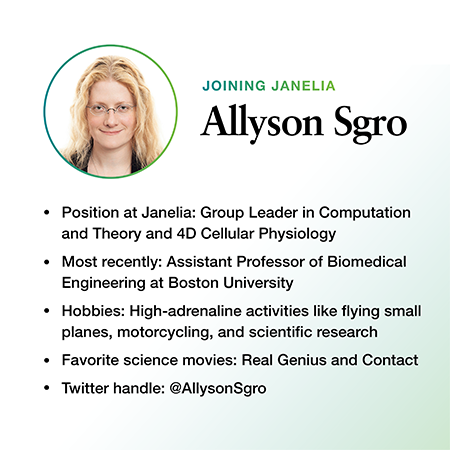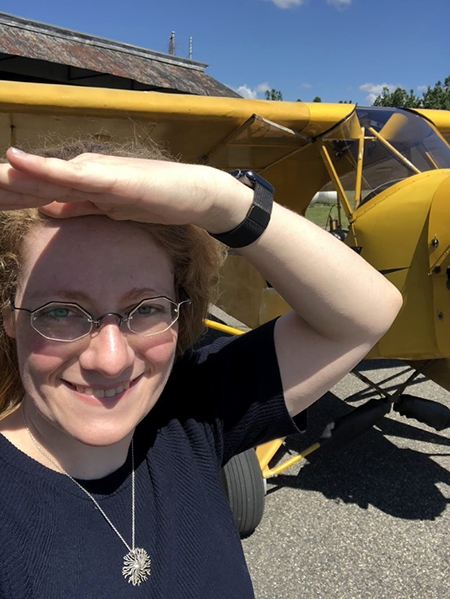Allyson Sgro’s path to science started early—she entered college without ever graduating from high school. At Bard College at Simon’s Rock, Sgro pursued her love of science through majoring in chemistry, leading her to earn a PhD in chemistry focusing on developing methods for quantitative biology and neuroscience. After she developed an allergy to mice, Sgro pivoted to slime molds and how they process information to work together, leading her to her current research where she works to understand how cells, in general, coordinate their behavior. We sat down with Sgro to hear more about her research and her decision to join Janelia.

HHMI Janelia: First, tell us a little bit about your research.
Allyson Sgro: Broadly speaking, I’m interested in how groups of cells compute and work together. We traditionally think of brain cells as the ones doing computations, but all cells need to process information to work together as part of a group. These cells can be anything from microbes that live in the soil to bacteria in your gut or on your skin. My research focuses on how groups of cells deal with unexpected or changing circumstances. What kind of program inside a cell is able to deal with many different changes outside the cell to coordinate a response with other cells? Are there best practices these programs implement for cells to accomplish tasks together or many different good solutions?
Think about times when you’ve cut yourself. Every cut is different in several ways, including its depth and size. And yet there is repair program that’s able to deal with those differences and generally able to heal the wound. When microbes develop into a complex structure made of more than one cell—say, a slime mold in the woods, or bacteria in biofilms—they're able to do this over groups that vary by orders of magnitude in size and in very different environments, often with different genotypes or different species.
I’m interested in how these programs in our own cells or in cells in the world around us can be so robust and yet somehow produce the same outcomes under a variety of circumstances.
HJ: What drew you to Janelia and what is exciting about being here?
AS: There are several things [that drew me to Janelia]. One is the flexibility to change direction rapidly and the support to try new things. My lab was previously working in in vitro models and synthetic models of the biological systems we were interested in, and a lot of the limitations of those models became clear the deeper into the projects we got. I’m very interested in moving some of our studies into animal models and integrating some new techniques into our work and a place like Janelia has the expertise and support available to allow a lab to transition to working in a new model or with a new technique even when you don’t have the experience.
There is also a real joy in being able to do more of the science yourself, and I am really excited for that here. Having the time to work in the lab and working with other PIs in these small, collaborative groups is something that’s different from most academic settings.

HJ: You are part of Janelia’s new research area, 4DCP. What does that mean to you?
AS: I was really thrilled to start at the beginning of 4DCP and to be part of shaping projects that are bigger than just a single lab. There’s so much potential. I very much believe in why Janelia picked 4DCP as the next big problem. This idea of: How do we understand processes across spatial and temporal scales? How we understand what information is preserved and passed along through time, across locations, and between special scales is one of the most central problems in biology that is still unsolved. I think that this research area will change the way people think about living systems. And I want to be a part of that.
HJ: What motivates you and excites you about your research?
AS: First, I like never being bored, and research is never boring. There are many different things going on in science, many different parts of projects, and many challenges when running a lab that change from day to day, so there’s always something new. I enjoy thinking about how to fit all the parts of this job and all the pieces of scientific puzzles together. In any scientific problem, you’re going to run into a wall on something, and it takes time, hard work, and discipline to get past it. Part of what I appreciate about there being many different parts to tackling a scientific question is that sometimes you can put down those things that aren’t working and focus somewhere else to get a new perspective.
I also enjoy the opportunity to keep many different skills sharp to address the research problems I work on. They require everything from good visual problem-solving skills to good math skills to good computational skills. Learning how to do something well and continually improving on it are two things I deeply enjoy.
HJ: What do you like to do when you’re not in the lab?
AS: I’ve got a bunch of hobbies, but the one I’m excited to be able to enjoy more easily at Janelia is flying small planes. We’re very close to a small airport where you can rent a plane and enjoy being up in the air. The scenery here is even better from above!
HJ: You’ve been living on campus as a visiting scientist since April. Do you have a favorite spot on campus yet?
AS: I love walking across campus from the south side toward the Landscape Building. When you get to the top of the Landscape Building, you look down and you see the building cascade down the hillside in front of you. You can’t help but think, "Oh, wow, here I am. I’m really here."
Sgro Lab / We take a joint theory-experiment approach to understanding how groups of cells integrate information about their environment and each other to work together.
